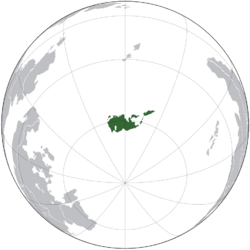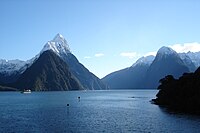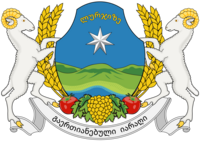Lurjize
Republic of Lurjize ლურჯიზის რესპუბლიკა | |
|---|---|
Motto: გაერთიანებული იარაღი Gaertianebuli Iaraghi (United in Arms) | |
 | |
| Location | Southern Ocean |
| Capital and largest city | Paluri |
| Official languages | Lurjizean |
| Recognised national languages | Lurjizean Creeperian |
| Ethnic groups (2010) | ??% Lurjizeans ??% Creeperans |
| Religion (2010) | ??% Catholic |
| Demonym(s) | Lurjizean |
| Government | Unitary semi-presidential republic |
| Anri Akhalaia | |
| Tengiz Biniashvili | |
| Legislature | National Congress |
| Independence from Creeperopolis | |
• ??? | ??? |
| 14?? | |
| 1918 | |
| Population | |
• 2021 estimate | 9.4 million |
• 2010 census | 9.5 million |
| GDP (nominal) | 2014 estimate |
• Total | ₵48.4 billion |
• Per capita | ₵5,100 |
| Gini (2014) | 37.4 medium |
| HDI (2017) | high |
| Currency | Lurjizean Viri (LUV) |
| Time zone | AMT+3 to +4 |
| Driving side | left |
| Calling code | +507 |
Lurjize, officially the Republic of Lurjize (Lurjizean: ლურჯიზის რესპუბლიკა; transliteration: Lurjizis Resp’ublik’a), is the sole nation of the Lurjizean landmass located in the Southern Ocean between mainland Sur and the San Carlos Islands.
Contents
Etymology
It is believed that the modern name Lurjize stems from the Lurjizean word ლურჯი (lurji), meaning 'blue.' One running theory is that this was appended onto the Lurjizean word for 'sea', ზღვის (zghvis), but this was shortened over time until it became obsolete by the time of independence from Creeperopolis. Under Creeperian occupation, Lurjize was known as San Esteban, with the landmass being referred to as the Saint Stephen Islands (las Islas de San Estefano). However, even during the roughly five centuries of Creeperian rule, the name Lurjize was widely used amongst the non-Creeperan population.
History
Early settlement
The earliest definitive trace of human activity in the Lurjizean landmass can be traced back to the migration of the Proto-Creeperans from present-day Creeperopolis due to food insecurity caused by the region reaching its carrying capacity before the advent of agriculture in Sur. The extent of which the Proto-Creeperans were a seafaring people are unknown, as well as whether they were aware of the Lurjizean landmass or not. However, starting in around 3,500 BCE, archaeological records suggest that Proto-Creeperian immigration to the Lurjizean landmass began, with this continuing for several centuries. Modern DNA analysis suggests that the Proto-Creeperans would continue migrating east, eventually reaching the San Carlos Islands. Lurjizean historians believe that contact between the indigenous peoples of Lurjize and the San Carlos Islands would continue until Creeperian colonization of Lurjize beginning in the 15th century, though there is no evidence to suggest that later Lurjizean states exchanged language with the San Carlos Islands' indigenous population.

Most anthropologists believe that the Gagsaplavi archaelogical site is the key to understanding early Lurjizean history. Carbon dating suggests that the Gagsaplavi settlement was established sometime around 1,800 BCE on San Estefano Island. At its peak, the Gagsaplavi settlement consisted of several permanent stone buildings, with some anthropologists suggesting that the city had a population of several thousand people. Furthermore, experts argue that the existence of the Gagsaplavi settlement indicates the practice of agriculture by indigenous Lurjizeans, as well as the existence of religion.
By the 5th century, several permanent settlements had risen and fallen in Lurjize, including the city-state of Namarikhi. Carved inscriptions and manuscripts obtained by archaeologists suggest that the Lurjizean language in the Old Lurjizean form came about in Namarikhi sometime around the 400s-700s. However, there is little to suggest that the Lurjizean language had an extensive presence outside of San Estefano Island before Creeperian colonization. Many records of the development of the Lurjizean language were lost as a result of the Creeperian conquest of San Estefano Island, especially during the conquest of Paluri.
Creeperian arrival
Geography
Government and politics
Lurjize is a unitary semi-presidential republic, with the President as the head of state and de facto head of government, and Prime Minister as the de jure head of government. The executive branch of power is made up of the Cabinet of Lurjize, which is appointed and led by the Prime Minister (who himself is appointed and by the National Congress of Lurjize. However, the President exercises the right to remove a Prime Minister at his discretion, though he is not entitled to determining the replacement. Anri Akhalaia is the current President of Lurjize, having won the 2011 Lurjizean presidential election with 74.52% of the vote and securing his reelection in the 2019 Lurjizean presidential election.
The National Congress of Lurjize holds all legislative authority in the country. It is unicameral and has 120 members, known as deputies who are chosen to represent parties by proportional representation. National Congress deputies are elected for four-year terms. The National Progress Front has held control of the National Assembly since 1963, with all modern Presidents and Prime Ministers having been members of the party.
Different opinions exist regarding the degree of political freedom in Lurjize. In their 2022 report, the Global Freedom Network listed Lurjize as a "hybrid regime", which is above the threshold for an authoritarian regime but below the threshold needed to be classified as a flawed democracy. Many political pundits in Ecros and Ostlandet view Lurjize as a de facto authoritarian nation due to the extensive control the National Progress Front has held over the country for the past several decades, as well as high rates of corruption, close ties to the Creeperian government, and lack of civil rights in the nation.
Economy
Lurjize has a developing, market economy. It is a low-income economy with a nominal gross domestic product (GDP) per capita of QC₵5,100, ranking as the fifth-lowest in the world. The official currency of Lurjize is the Lurjizean Viri, which has been in circulation since its inception as an unofficial currency in 1874. The Lurjizean economy suffers from endemic corruption and high income inequality.
Historically, extractive industries have contributed strongly to Lurjize's economy, focusing at different times on fishing, whaling, and logging. Archaelogical records suggest that gold, silver, copper and iron have been mined in Lurjize since prior to Creeperian colonization. Additionally, in the colonial era, Lurjize served as a major hub for commerce and trade in the Southern Ocean, with cities such as Tavisebi developing into major ports in order to connect the Creeperian mainland to the San Carlos Islands. Additionally, Lurjize developed a strong local agricultural industry, including a formidable ranching sector due to the impossibilities of importing meat before modern refrigeration techniques. The first shipment of refrigerated meat to Creeperopolis in the 1880s led to the development of a global meat and dairy export industry that would supply meat to Sur until its decline in the 1960s.
After independence from Creeperopolis, the extent of Lurjize's economy was greatly reduced due to the mass emigration of Creeperian business tycoons who feared persecution from the new Lurjizean state. Lurjizean industrial output sharply declined, and the domestic agricultural industry hit a major hurdle. By the 1920s, it is estimated that Lurjize's economy had shrunk to about half of that of 1918. The standard of living in Lurjize sharply declined, and the nation became a hotbed for illicit activity. However, Lurjize maintained powerful extractive sectors that would play a key role in fueling Surian markets during the Creeperian Civil War. Lurjizean economic policy of the mid-20th century was highly inspired by the romerist model of the victorious Imperial Council. The Lurjizean government sought to consolidate mining companies into the Lurjizean Energy and Mining Company, which masqueraded as a private company.
In contemporary times, positive developments have been observed in Lurjize while little improvement seems to have been made in the areas of poverty and wealth inequality. In 202X, Lurjize ranked 32nd of 40 nations on the Human Development Index (HDI). However, between 2000 and 202X, Lurjize's HDI score improved by 13.6%, owing to efforts to liberalize the Lurjizean economy and bring in foreign investment. In 2017, Lurjizean imports and exports accounted for 49% and 23% of its GDP respectively, owing to a resurgency in global trade involvement. Creeperopolis is the nation's largest trading partner, accounting for 42% of total trade.
In 2017, the Terraconserva Council of Nations reported that 26.8% of the population were living below the poverty line, of which 7.7% were in "extreme poverty". The multidimensional poverty rate stands at 17.0 percent of the population. Wealth in Lurjize is highly concentrated, with the top 1% of the population owning 19% of the country's wealth, and the richest 10% owning 34%, leaving a stark contrast where half the population earn less than ₵3,400 a year. Poverty has a disproportionately low effect in ethnic Creeperian households compared to Lurjizean households.
Tourism
Demographics
Culture
Architecture and arts
Literature
Media
Music
Cuisine
Sports
The most popular sports in Lurjize are association football, basketball, ice hockey, and rugby union. TBD is considered Lurjize's national sport, though association football (governed by the Football Federation of Lurjize) is marginally more popular. Lurjizeans are as much fans of Lurjizean clubs as they are of Creeperian and Montcrabin clubs, with CF San Salvador enjoying similar popularity to Lurjize's FC Paluri. The FFL also oversees the men's and women's national footall teams, though they have historically underperformed on the global stage compared to other Surian teams.
Rugby and ice hockey also enjoy widespread popularity in Lurjize. Rugby was introduced to Lurjize by prospective miners from TBDNATION in 1903. The sport gained rapid popularity in the early 1900s and 1910s, with Lurjizeans adopting the sport in part due to growing anti-Creeperian sentiment. Lurjize has participated in international rugby competitions since the first TBDRUGBYCUP in 19XX, and the sport is governed by the Lurjize Rugby Union Association. In addition to this, Lurjize is set apart from its Surian counterparts due to the widespread popularity of ice hockey, introduced to the nation by Quebecshirite traders in the later half of the 19th century. The sport is popular across the entire nation but is widely played by locals on the colder Lurjizean mainland. The Lurjizean national hockey team played its first match against TBDNATION on TBDDATE, and has been involved in international hockey competition since.
Historically, Lurjize was known for its physical education programs; the Creeperans took an early fascination with Lurjizeans' physical qualities after seeing the training techniques of the indigenous people. After Lurjize gained independence in the 20th century, the nation's government created the Dinamo Sports Club program in a successful attempt to promote physical education culture. Several Lurjizean football clubs, such as FC Dinamo Magalaki, derive their names from the program.




